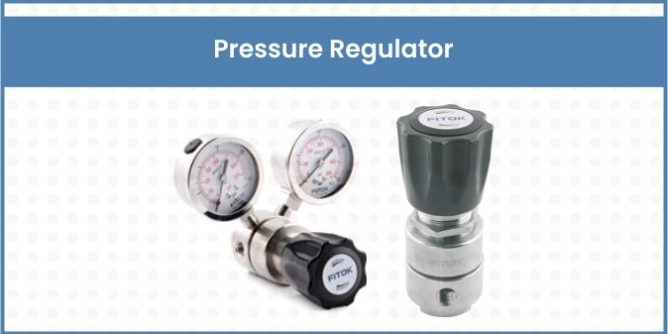
A pressure regulator is a device that controls the pressure of liquids or gases (medium) by reducing a high input pressure to control lower output pressure. They also work to maintain a constant output pressure even when there are fluctuations in the inlet pressure.
Two types are available- The pressure reduction regulator and the back-pressure regulator.
- A pressure reducing regulator is a control valve that reduces the input pressure of a fluid or gas to a desired value at its output. It is a normally-open valve and is installed upstream of pressure sensitive equipment.
- A back-pressure regulator is a control valve that maintains the set pressure at its inlet side by opening to allow flow when the inlet pressure exceeds the set value. It differs from an over-pressure relief valve in that the over-pressure valve is only intended to open when the contained pressure is excessive, and it is not required to keep upstream pressure constant. They differ from pressure reducing regulators in that the pressure reducing regulator controls downstream pressure and is insensitive to upstream pressure. It is a normally-closed valve which may be installed in parallel with sensitive equipment or after the sensitive equipment to provide an obstruction to flow and thereby maintain upstream pressure.
Selection criteria for Pressure regulators-
Pressure regulators are available in various sizes and constructions, but below are a list of considerations to choose the correct pressure regulator for the application:
- Operating pressure range
- Capacity or flow required
- Nature of the medium (fluid or gas) transmitted
- Operating temperature range
- Material requirements
- Accuracy required
Operating Pressure range
The input and output pressures required in the application determine the type of regulator to be used:
- The supply range of the input pressure that can be handled safely.
- The required values of output pressure.
- The required accuracy of output pressure.
Capacity or flow requirements
The following criteria should be evaluated:
- The maximum flow rate required.
- The variation expected in flow rate.
- Correct selection of pipe size.
Nature of medium (fluid or gas)
Care should be taken about the type of medium to be used in the regulator:
- Liquid / Gas
- Chemical composition
- Flammability / Explosive nature
- Hazardous / Toxic nature
- Corrosive properties
Operating temperature range
The materials used in pressure regulators should be such that they need to be able to perform their function effectively at a certain operating temperature range, without losing their material properties. The elastomers used for regulator sealing can be selected as below:
- Nitrile (NBR) or Neoprene (-40 0C to 82 0C)
- Ethyleneproplene (EPDM) or Perfluoroelastomer (FKM) for higher temperatures
Material requirements
Depending on the medium and operating conditions, various regulator component materials are available such as:
- Brass – Commonly used and economical
- Plastic – Cost effective / disposable application
- Aluminum – Weight considerations
- Stainless steel – Corrosive environments, high cleanliness requirements and high operating temperatures.
The seal used in the pressure regulator should be compatible with the operating temperature and type of medium used.
The size and weight of the pressure regulator are important considerations. The material used, required port size, adjustment requirements and type of mounting should be taken into account to select the appropriate type.
Accuracy required
Reliable pressure control is essential to the safe operation of your fluid systems. FITOK offers our customers a variety of options and configurations to meet almost any application. We have a variety of options and configurations to meet almost any application, and our
A B Process Technologies advisors can help you find a configuration that will maintain pressure and minimize droop over a wide range of pressures and flows.
